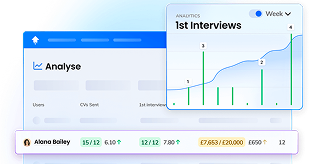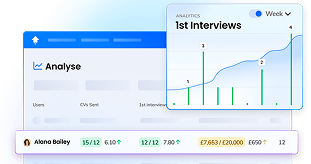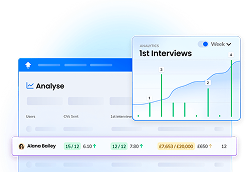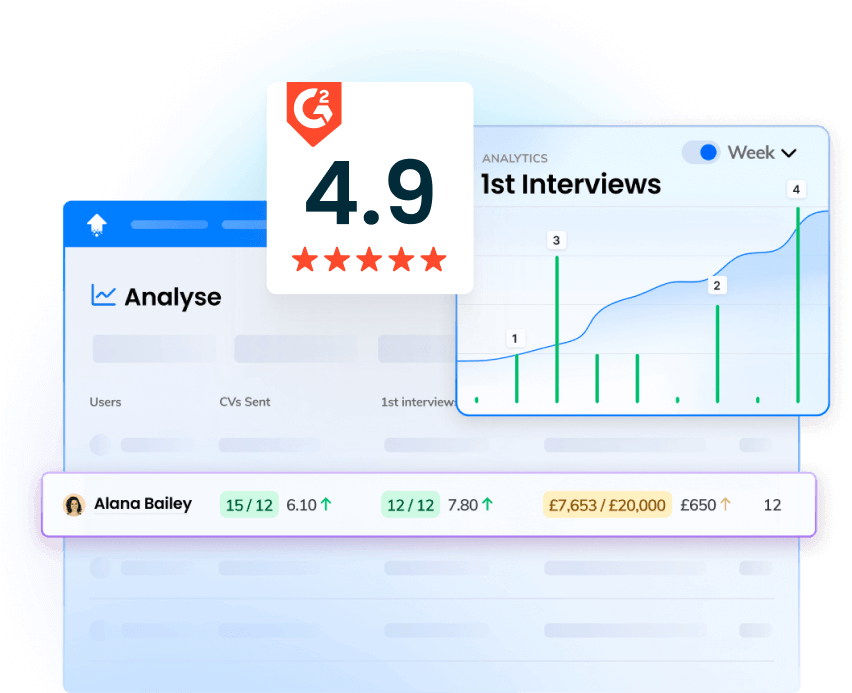Every recruitment agency constantly strives to improve recruitment process plans, strategies, and tactics.
Because building a more effective process helps you win better clients, find better-qualified candidates, and fill placements faster.
That’s why you need to develop a recruitment process improvement plan — a strategic document containing scalable, repeatable steps to deliver efficiencies and level up the performance of your recruitment team.
Read on to learn:
- The benefits of improving your recruiting process
- The key components of a recruitment process improvement plan
- The five steps to building your own plan
Let’s get into it.
Understanding Recruitment Process Improvement
As a team leader or senior director at a recruitment agency, you’ve always got one eye on how to improve recruitment process outcomes.
While you can make a certain amount of progress by targeting low-hanging fruit, you won’t see truly transformational gains until you get to grips with the fundamentals underpinning how your agency works: your recruitment funnel.
At OneUp, we view the recruitment funnel in terms of the key metrics that apply to each step:
- Jobs added
- CVs sent
- Interviews booked
- Placements filled
- Revenue
Analysing this typical funnel allows you to set goals for the ratios you should be hitting at each stage.
For instance, consider the interview process. By looking at your historic data, you might see that it takes an average of five CVs sent to book an interview, and that you need seven booked interviews to successfully place a candidate.
Once you understand the interplay between the different funnel stages, you can optimise what happens at each step to deliver better results for you and your clients.
To give one example, you might start using AI to vet CVs faster.
That way, it may become far easier (and quicker) for your recruiters to deliver the five CVs required, on average, to secure an interview.
Or, by combining the efficiency of AI with the expertise of human recruiters, you might find it’s easier to identify high-quality CVs — so you don’t need to send as many.
Whatever the case, the end result is that it now takes you less time to fill the role.
In other words, when you focus on how to boost recruitment funnel activity, everyone wins.
Benefits of Recruitment Process Improvement
We’ve discussed how optimising your recruitment process can deliver better outcomes for you and your client's hiring process.
Now, let’s look at the specific benefits of recruitment process improvement:
Win Better Clients
Because you’re operating more efficiently, you no longer need to take on any and every client that comes your way, just to keep pace with your revenue targets.
In effect, you’re doing more with less.
That gives you the bandwidth to focus on building sustainable, mutually beneficial relationships with employers that truly align with your ideal client profile.
Find Better Potential Candidates
Working with better clients means you can take the time to understand exactly what they’re looking for in their talent search.
In turn, this gives you the insight to track down higher-quality candidates who perfectly fit the client’s company culture, as well as possessing all the necessary skills and experience.
Send the Right Candidates for Each Role
By this point, you should be able to see how all these benefits are interlinked.
When you attract candidates of higher quality, you can put forward only the very best for each role, so the client spends less time leafing through average CVs and interviewing job applicants who just aren’t a good fit for their business.
Fill Placements Faster
And what happens when you consistently put forward the right job-seekers for each and every vacancy?
Simple: it takes you less time to fill a placement and you’ll fill placements at a higher win ratio.
Which, in turn, means you can…
Drive More Revenue (More Efficiently)
When your recruitment funnel is a well-oiled machine rather than a rusty old relic, it becomes (comparatively) easy to smash your revenue goals.
You can scale your team, safe in the knowledge that new recruiters will get up to speed fast using your standardised processes and strategies.
So you can feel confident that when you win new business, you’ll be well placed to meet their needs.
Challenges Faced by Recruitment Teams
Reading that last section, leading a recruitment team sounds simple.
Of course, we all know that’s not the case.
Recruitment teams face a wealth of challenges, all of which can block you from satisfying your clients and achieving your growth goals.
Challenges like…
Lack of Data Visibility
Today’s recruitment teams do way more than funnelling CVs to hiring managers.
They need to:
- Source new jobs
- Find the most-qualified candidates
- Track progress to targets in real-time
But they can’t do that without having easy, always-on access to key recruitment data.
Trouble is, much of that data is often locked away in CRMs with basic reporting functionality, or scattered between dozens of spreadsheets.
At best, this forces recruiters to waste a bunch of time piecing together the data they need from multiple sources. At worst, it makes it near-impossible for them to do their job.
Inefficiencies in Current Systems
Of course, inefficiencies affect more than just access to data.
They slow down CV vetting, hamstring communication with prospective employees and clients, waste time on advertising new jobs, and much more besides.
That’s why it’s so important to build a recruitment process improvement plan that weeds out these inefficiencies — leaving you with a streamlined, standardised recruitment funnel.
The Complexity of Data Analysis Tools
We’ve already noted the importance of data visibility to the modern recruiter.
Unfortunately, while many CRMs and spreadsheets aren’t fit for purpose, many of the dedicated data analysis tools fall short in a different way: they’re simply far too complex for non-specialists to make sense of.
This makes it tough for recruitment team leaders to make the data-driven decisions required to optimise recruitment processes.
Key Components of the Recruitment Process Improvement Plan
A recruitment process improvement plan contains a lot of moving parts.
Be sure to consider the following factors and actions when building your plan:
Identifying Key Metrics and KPIs
The “D” word again.
Data is key to understanding the performance of your existing recruitment process.
And if you don’t understand how you’re currently performing, it’s impossible to make meaningful improvements.
Start by setting metrics and KPIs covering the key stages of your recruitment funnel. As we’ve already explained, we believe the following metrics make most sense:
- Jobs added
- CVs sent
- Interviews booked
- Placements filled
- Revenue
When you know how many jobs you’re adding or candidate resumes you’re sending in a typical week, month, or quarter, you can identify weaknesses in your current process.
Like, maybe you’re sending a bunch of CVs, but they’re not translating to booked interviews — which means it’s taking too long to fill placements and holding back your revenue generation.
In that case, it seems like the candidate and CV-vetting stage of the process is a logical place to start your improvement plans.
Data Collection and Analysis Tools
If data is essential to building a more efficient recruitment process, but most data analysis tools aren’t up to scratch, what are you supposed to do?
We’ve got the answer: use OneUp!

Our recruiting analytics software gives you the visibility you need to hit target, faster:
- Pull data from multiple sources, like your CRM and VoIP system, to create a single source of truth for your most important numbers.
- Create custom dashboards and reports for your team members and senior leaders.
- Build automated reports so you can keep your team informed without spending hours every week manually pulling data from different sources.
The Role of Team Leads in Process Enhancement
As a recruitment team leader, you’re best placed to drive improvements in your recruitment process.
Why? Because agency leaders are too far removed from day-to-day activities to identify inefficiencies and find solutions.
Of course, you don’t have to do it all alone. “No man is an island,” as Hugh Grant says in About a Boy.
Once you’ve found areas for improvement, present them to senior leadership.
Then, when you’ve got the green light, it’s your job to implement the changes, present them to your team, and provide any necessary training.
Building Your Recruitment Process Improvement Plan
Enough theory: here’s a practical, five-step process for building, rolling out, and continuously optimising your recruitment process improvement plan.
Step 1: Data Assessment and Gathering
Your recruitment process improvement plan will only be as strong as the data it’s based on.
So the first step is to assess the types of data you need in order to assess the performance of your existing recruitment process, then get on with gathering it.
Chances are, you’ll want to consider broad metrics covering the entire recruitment funnel — such as time-to-fill — as well as more granular ones that speak to a specific part of the process (like CVs sent and first interviews booked).
Points to consider:
- Data sources: Are they up to scratch? Do they provide the visibility you (and your team) need to meet your clients’ goals?
- Data coverage: Are there any gaps in your existing data? If so, how can you close them? Do you need to build new reports, connect more data sources, or consider a different reporting and analytics platform?
👉 Find out more: From Outreach to Onboarding: 17 Recruiting KPIs to Track
Step 2: Setting Clear Objectives
It’s impossible to improve your recruitment process if you don’t know what “improvement” looks like.
Ultimately, the goal of any recruitment agency is to make money.
But there are any number of ways to achieve that, from targeting higher-paying clients to driving efficiencies so each recruiter on your team generates more revenue.
Not all of those goals will be mutually compatible, so you’ll need to define what really matters before setting objectives for your improvement plan.
Points to consider:
- Goal measurement: Can your goal be tracked and measured? At the end of a given time period, will you be able to categorically say whether you hit target or fell short?
- Goal alignment: Do your objectives match those of your senior leaders? If not, don’t expect to get buy-in for your plans.
👉 Find out more: How to Set SMART Goals for Recruiters
Step 3: Selecting the Right Tools
Nowadays, there are tools for everything.
Many aren’t worth the code they’re built from, but some will help you deliver substantial improvements to your recruitment process.
While the specifics of your recruitment tech stack will naturally depend on the requirements of your agency, we truly believe that most agencies would benefit from OneUp’s recruitment software platform.
With OneUp, you can:
- Build reports in minutes, not hours, freeing you up to focus on high-value actions like data analysis and strategic decision-making.
- Automate and share recurring reports so your team members and leadership team always know what’s going on.
- Set transparent targets by giving your team access to custom reporting dashboards displaying the numbers that matter to them.
- Foster healthy competition through real-time leaderboards, competitions, and challenges.
👉 Find out more: Recruitment Software Platform from OneUp Sales
Points to consider:
- Tool overload: Only choose tools that save you time, make you money, or both. Otherwise, you’re just forcing your team to learn another platform that won’t make a material difference to your performance.
Step 4: Data Analysis and Insights
By this point, you’ve set various goals for your recruitment process improvement plan, potentially covering the entire recruitment funnel.
However, those goals mean nothing if you don’t have the tools to analyse the data and draw meaningful, actionable insights from it.
For instance, a report might reveal that interview bookings are up 5 percent month on month.
On its own, this tells you nothing.
You need to analyse the data to find out why performance has improved. Is it because you implemented a new applicant tracking system? Shared job postings on different job boards? Ran a training programme? Experimented with a different style of well-written job description?
This is the stuff that sets the best team leaders apart.
Unfortunately, as we’ve already pointed out, most data analysis tools make it needlessly difficult for non-specialists to find all the numbers they need.
That’s why you need OneUp.
Our reporting and analytics platform makes it easy to:
- Deep-dive into analytics to understand what contributed to your results over any time period.
- Combine all your metrics in a single view, with drag-and-drop tables helping you analyse each stage of your talent pipeline, fast.
- Save as many reports as you need so your most important numbers are always just a click away.
👉 Take a tour of our Reporting and analytics software for recruitment teams
Step 5: Implementation and Monitoring
You’ve got all the metrics, goals, and tools in place to execute your recruitment process improvement plan.
Now it’s time to make it happen.
Sign up for all the necessary tools, plot out your new workflows, and communicate all the changes to your team.
On that final point, remember to brief your team in a way that feels relevant and personalised to their own goals and motivations.
For instance, rather than telling them that a new process will save the agency time, explain how the efficiencies will make it easier to hit their targets and earn higher commissions.
Points to consider:
- Training and development: Do your recruiters have everything they need to start executing your plans? Or do you need to train them on specific tools and processes?
- Continuous monitoring and optimisation: Improving a recruitment process is never a one-and-done exercise. By consistently monitoring performance throughout the recruitment funnel, you’ll inevitably identify further efficiencies and optimisations.
Conclusion
Recruitment process improvement planning is no easy task.
If it was, every recruitment agency would already be operating at peak performance.
But it’s worth the effort. Because every agency wants to…
- Win better clients
- Find qualified candidates faster
- Fill placements more efficiently
And, of course, earn more revenue.
While there are no shortcuts, OneUp makes the process of developing an improvement plan significantly easier by giving you all the data you need, at your fingertips, in an easy-to-digest format.
Plus our gamification tools help motivate your team, encouraging them to deliver the full benefits of your new, optimised recruitment process.
See what OneUp can do for your recruitment team by booking your demo today!




















